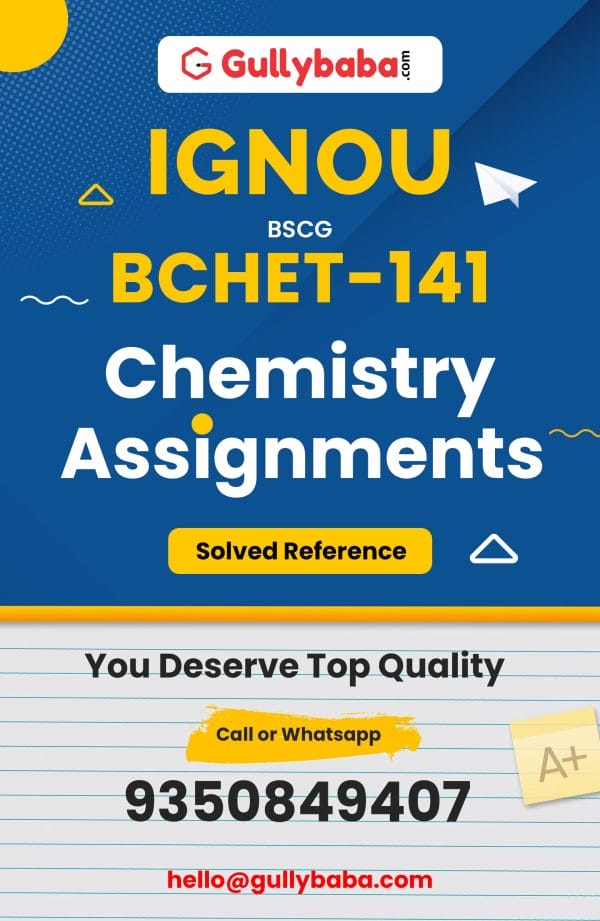
#1 Best Selling IGNOU CBCS Assignments in All Available in Market
Bought By: 2269 Students
Rating:
Get IGNOU BCHET-141 Assignments Soft Copy ready for Download in PDF for (January 2024 - December 2024) in English Language.
Are you looking to download a PDF soft copy of the Solved Assignment BCHET-141 - Analytical Methods in Chemistry? Then GullyBaba is the right place for you. We have the Assignment available in English language.
This particular Assignment references the syllabus chosen for the subject of Chemistry, for the January 2024 - December 2024 session. The code for the assignment is BCHET-141 and it is often used by students who are enrolled in the BSCG Degree.
Once students have paid for the Assignment, they can Instantly Download to their PC, Laptop or Mobile Devices in soft copy as a PDF format. After studying the contents of this Assignment, students will have a better grasp of the subject and will be able to prepare for their upcoming tests.
Part A
1. Writ the procedure for the collection and preservation of water samples.
2. Define Indeterminate errors. How we can reduce them.
3. What is significance of t-test? Explain using a suitable example.
4. Which reagents are used for extraction by solvation? Give suitable examples.
5. Briefly explain the extraction by chelation. Also give some examples of the chelating agents used.
6. Explain continuous extraction with the help of a suitable diagram. Which factors govern the efficiency of such extractions?
7. Draw a flow chart for the classification of various types of chromatographic techniques.
8. List different criteria for choosing the mobile phase used in paper chromatography.
9. Discuss the principle of coloumn chromatography illustrating the experimental setup.
10. Briefly explain various types of capacities associated with ion exchangers.
Part B
11. Discuss the factors which limit the accuracy of pH measurements.
12. Discuss design and working of silver-silver chloride electrode.
13. How the conductance is varies with concentration? Explain with the help of suitable examples.
14. Explain ionic nobilities and transport number.
15. Taking suitable examples explain the effect of furnace atmosphere on TG curves.
16. An impure sample of CaC2O4, H2O is analyzed using TGA technique. TG curve of the sample indicates the total mass change from 85 mg to 30.7 mg when this sample was heated up to 1173 K. calculate the purity of the sample.
17. Write the shortcomings of wave model of electromagnetic radiation. Describe the model that was able to explain these shortcomings.
18. Write the expression of Lambert’s and Beer’s law. List the factors responsible for the deviation from Beer-Lambert’s law.
19. What is the necessary condition for observing IR spectrum? Describe in brief the types of vibrations for a polyatomic molecule.
20. How are the signals in an atomic spectrum characterized? Illustrate your answer.
PART A
1. How will you carry out collection of water samples and their preservation?
2. Write various sources of Determinate Errors.
3. What is F-test? To illustrate “F” test suppose that two series of observations are made one of 4 observations of standard deviation equal to 0.02 and another of 6 observations of standard deviation equal to 0.04. Then what do we have to test?
4. Explain the terms-distribution ratio and distribution coefficient. When are these two terms not identical? Discuss.
5. When is solvent extraction useful? Using suitable diagram, explain how it is carried out.
6. Explain various types of liquid chromatographic techniques with the help of a suitable diagram.
7. How can you separate the components A, B and C of a mixture using paper chromatography? Explain using suitable diagram. (Rf value of B is greater than A but less than C.)
8. What are the similarities and differences in adsorption and partition chromatographies?
9. Explain the development of chromatogram for the separation of the mixture containing three compounds P, Q and R using frontal analysis. Give suitable diagram also.
10. Discuss natural ion exchangers by giving suitable examples.
PART B
11. Derive the Nernst expression for a galvanic cell.
12. What are the characteristics of a reference electrode? Describe the construction and working of a Calomel electrode.
13. What are molar conductivity and limited molar conductivity? Resistance of a conductivity cell filled with 0.1M KCl solution is 100 Ω. If the resistance of the same cell when filled with 0.02 M KCl solution is 520 Ω, calculate the conductivity and molar conductivity of 0.02 M KCl solution. The conductivity of 0.1 M KCl solution is 1.29 S m-1.
14. Discuss various sources of errors in TGA.
15. A mixture of CaCO3 and CaO is analysed using TGA method. TG curve of the sample indicates that there is a mass change from 290.6 mg to 230.8 mg between 500-900°C. Calculate the percentage of CaCO3 in sample.
16. Briefly explain the nature of spectra in atomic and molecular systems with the help of suitable examples.
17. Discuss the methodology of quantitative determinations by UV-VIS spectrometry.
18. a) Describe the steps involved in getting IR spectrum of the sample using FT-IR instrument with interferometer.
b) List the advantages of FT-IR instrument over dispersive IR instrument.
19. Explain the characteristics of atomic spectra.
20. Discuss the merits and limitations of FAE spectrometry.
The IGNOU open learning format requires students to submit study Assignments. Here is the final end date of the submission of this particular assignment according to the university calendar.
Here are the PDF files that you can Download for this Assignment. You can pick the language of your choice and see other relevant information such as the Session, File Size and Format.
In this section you can find other relevant information related to the Assignment you are looking at. It will give you an idea of what to expect when downloading a PDF soft copy from GullyBaba.
In addition to this Assignment, there are also other Assignments related to the BSCG Chemistry you are preparing for. Here we have listed other Assignments that were bought along with this one.